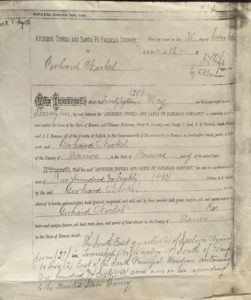
FREE Short Story: The Seamstress
For your FREE short story, type your email address below.
You'll get the short story, plus fun facts about the Wild West, and news about upcoming stories.

For your FREE short story, type your email address below.
You'll get the short story, plus fun facts about the Wild West, and news about upcoming stories.
In a July 4, 1861 speech, President Abraham Lincoln told the nation the purpose of America’s government was “to elevate the condition of men, to lift artificial burdens from all shoulders and to give everyone an unfettered start and a fair chance in the race of life.”
In pursuit of this high ideal, Lincoln signed the Homestead Act on May 20, 1863, a piece of legislation that had a transformative effect on the United States. It led to Western expansion and allowed people from (almost) all walks of life – landless, poverty-stricken, former slaves, women, and recent immigrants – to become landowners.
My great-great grandfather, Gerhard Nickel, was a beneficiary of this Act. He and his impoverished family emigrated from Prussia (now northern Poland) to Kansas in 1875. The Homestead Act allowed him to acquire 160 acres of virgin prairie in the middle of Kansas. Homesteaders typically paid $18 to file a claim for a piece of land. They were then required to build a home on it of at least 12 x 10 feet, reside there at least six months out of every year, and if they were able to ‘prove’ the land (make it productive), they would be able to obtain outright ownership after five years.
In fact, Gerhard Nickel paid more for his 160 acres: the grand sum of $480. This is because he was recruited, along with many Mennonite farming families from his region of Prussia, by the Atchison, Topeka & Santa Fe Railroad Company. They were busy laying down thousands of miles of track across the continent, enabling homesteaders to reach new lands and send their produce back to eager consumers in the east.
When the railroad company built its route across Kansas, following the historic path of the Santa Fe Trail, they initially found it economically impossible because of the sparse population. Congress compensated the company with large land grants consisting of “every alternate section of land, designated by odd numbers, for ten sections in width one each side of said railroads”, totaling about 3 million acres. The company built town sites, many of them named after AT&SF officials, and sold the lands to immigrants. They even sent land agents over to Europe to recruit farmers, and found rich pickings among the Mennonites in eastern Prussia and Russia, whose religious freedoms were being threatened. The railroad company paid the immigrants’ travel expenses and helped them settle in the American Midwes t.
t.
Here is Gerhard Nickel’s purchase document, dated May 28, 1875, from the Atchison, Topeka & Santa Fe Railroad Company, specifying his land as the ‘southeast quarter of Section 27, Township 19 South, Range 2 East’, now known as Hillsboro, Kansas.
In total, 270 million acres, or 10% of all land in the United States, were settled under the Homestead Act. Agriculture was revolutionized and America’s Industrial Revolution took off as farmers demanded more and higher quality equipment and tools.
But Lincoln had a second motive for initiating this great land giveaway. It was also a political move against the slave-owning states of the South. In the dark days of the American Civil War, 1861-1865, Lincoln realized that the more populous the western non-slave states became, the greater the support for the North. Some historians speculate that Kansas and Nebraska might have become slave states if the soil and climate were better suited to southern cash crops like tobacco and cotton. In fact, the immigrants, and Mennonites in particular, brought their knowledge of wheat growing, and soon the US became known as ‘the breadbasket of the world’.
My great-great grandfather made a success of his land, growing the Turkey Red wheat from eastern Europe, but by the time his son, my great grandfather Gerhard G. Nickel, reached adulthood, there was no more land left to homestead in Kansas.
Many were pushing for more land to be made available, and by 1889 the pressure was so great that the US Government agreed to open up the Oklahoma Territory, previously given to Native American tribes as compensation for lands they’d been kicked off of farther east. Several tribes were once more shoved aside, and their land was allocated to eager settlers by means of a series of land runs. The biggest of these took place on September 16, 1893, and my great grandfather was successful in claiming the southeast quarter of Section 10, Township 21 North, Range 12 West, just north of present-day Fairview, Oklahoma.

I have imagined his family’s experiences – their pioneer spirit, the dangers, hardships, and accomplishments; as well as their social and moral dilemmas in occupying Indian land – in The Cherry Stone, a novel of The West.
The Pioneer Spirit was strong in those days, and many feel it is lost, to the detriment of society. But listen to these eloquent words of American Poet Carl Sandberg in 1937. Do they still apply?
Because the frontier and the free land is gone are we to lose the word “pioneer,” [worn] as the wood of an old ox yoke, homely as a one-room log cabin, fierce as famine, flies and vermin, tough and stubborn as men and plows breaking unbroken sod, mystic as rainbow lights on horizons not yet reached by man?
Shall we say across the next hundred years there will be more pioneers making headway favoring human solidarity as against war and strife among nations … winning changes toward better terms on which human beings shall live?
I hope so!
November 18, 2019
Some superb sources for this topic are: The Homestead National Monument, Beatrice, Nebraska, www.nps.gov; Kansas Historical Society www.kshs.org.
Fascinating history. A thorough and succinct overview. Thank you for providing this and can’t wait to read more!
Thanks, Nat! I’ll be scribbling again soon.